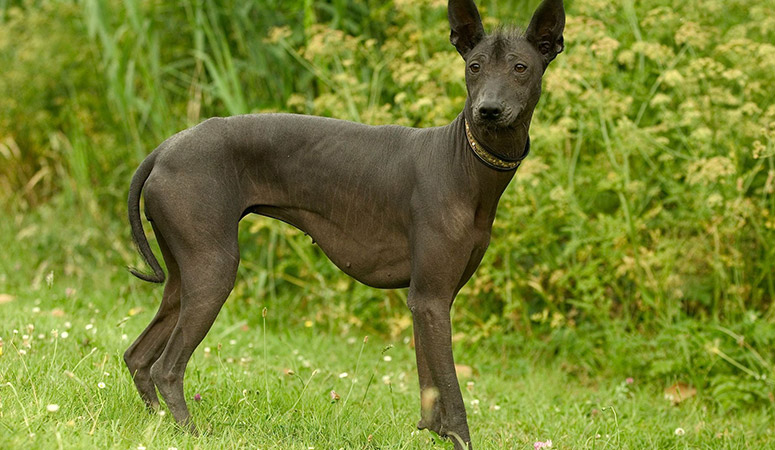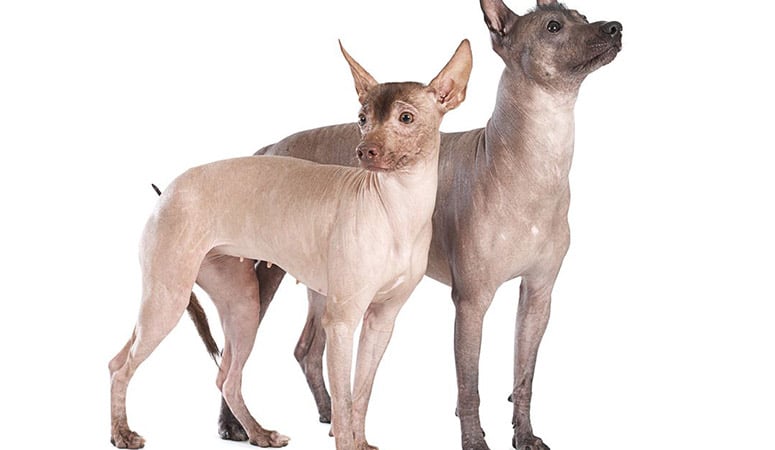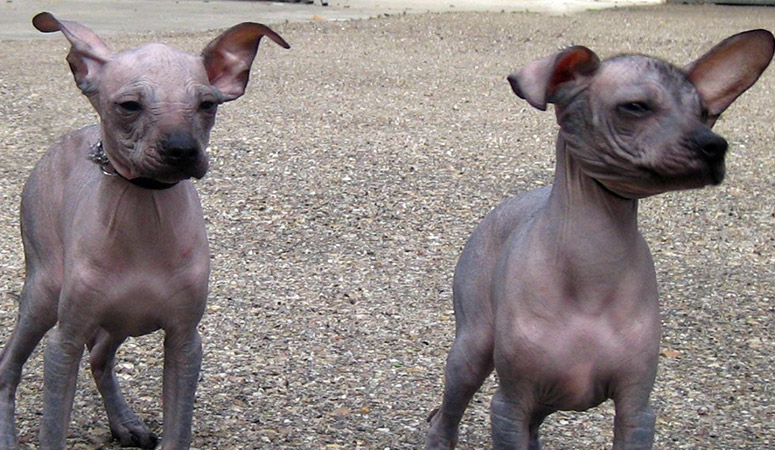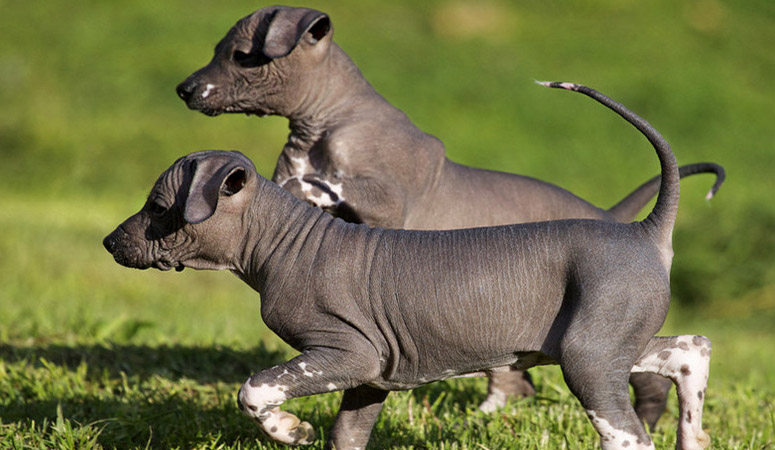Xoloitzcuintli
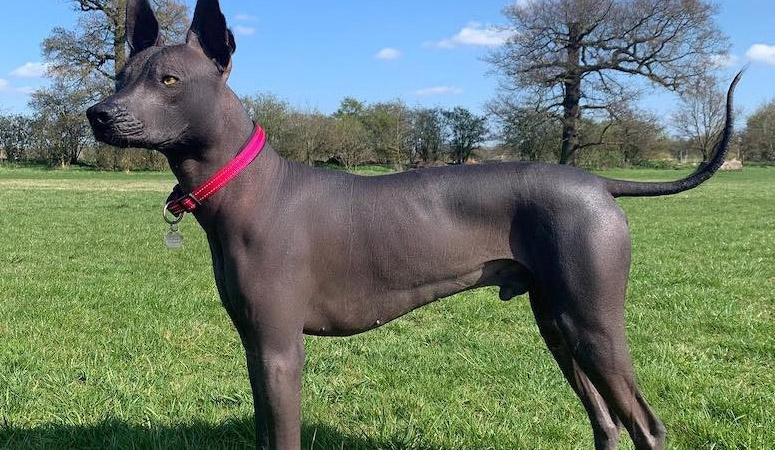
With a dominant hairless trait, the Xoloitzcuintli is often bald aside from a little hair on the head or tail. This breed comes in three sizes: toy, miniature, and standard and two varieties: hairless and coated. As a protector, they can protect the home with alert and loyal character. And today they are vigilant watchdog and loving companion.
| Other Names | Mexican Coated Dog, Mexican Hairless Dog, Xolo, Xoloitzcuintli, Xoloitzquintle |
| Color | Black, Brindle, Bronze, Dark Brown, Fawn,Gray, Liver, Palomino, Red, White |
| Height | Males: 17-24 inches. Females: 17-24 inches. |
| Weight | Males: 18-31 pounds. Females: 18-31 pounds. |
| Life Span | 13-18 years |
| Personality | Loyal, Alert, Calm |
| Exercise | Needs Lots of Activity |
| Origin |
| Popularity | #137 |
| Groom Needs | Occasional Bath/Brush |
| Kids Friendly | Yes with supervision |
| Dog Friendly | Yes with supervision |
| Watch Dog | |
| Family Dog | |
| Litter Size | 3-7 puppies |
Xoloitzcuintli Pictures
Xoloitzcuintli Video
Introduction
The Xolo is a typical example of a dog that was built to moderation. Its body is a bit longer than it is tall, and the distance between the elbow and the paw is almost equal to that from the elbow to the withers. Xoloitzcuintli have a general disposition to be calm and alert, keeping their aloofness to strangers– little wonder they make vigilant watchdogs. There are two coat varieties– the coated variety has a short, flat coat, while the hairless ones have a tough, smooth coat. The most common colors are different shades of red, gray, black, bronze, blue, and yellowish-blonde.
The Xolo appears in three size varieties– toy, miniature, and standard– all of which are trim and well-muscled. The toy-sized variety stands 10-14 inches at the shoulder and weighs a mere 10-15 pounds, while the miniature measures around 14-18 inches and weighs 15-30 pounds. Being the largest size of Xolo, the standard variety towers above the other types when it stands, at 18-24 inches and would normally tip the weighing scales in the range of 30-55 pounds. The Xoloitzcuintli has an average life expectancy of 12-18 years.
Living with Xoloitzcuintli
With easy-care short coat, Xoloitzcuintlis require low maintenance in terms of grooming. Shedding is not a problem with the hairless variety of Xoloitzcuintlis.
Even powder-puffs only shed moderately. Powder-puff Xolos require no more brushing or combing than any other moderately coated breed.
The hairless variety should not be over-bathed or over-moisturized, which can cause acne or other skin infections. Most owners bathe their Xolos only about once a month to prevent dry skin or irritation.
A light application of moisturizing skin lotion after a bath can help keep their skin supple, but it should not be overused. Lightly-colored Xolos may need additional grooming and more frequent application of sunscreen to protect their skin from sun damage.
The nails should be trimmed regularly, as overly long nails can cause the dog discomfort. Hairless dogs need sunscreen with prolonged exposure to direct sun. Veterinarian-recommended sunscreen should be applied before going outside, to prevent sunburn.
Teeth should be cared for in the same fashion as for most other breeds.
Xolos are perpetual puppies who need at least half an hour of exercise per day, more for larger, higher-energy dogs. Walking, easy runs, and romps in the yard will help meet this breed’s exercise requirements.
To keep boredom at bay, you’ll need to keep your Xoloitzcuintli engaged both mentally and physically. Bored Xolos may entertain themselves in ways you don’t find acceptable.
When given plenty of exercise and attention, the Xoloitzcuintli makes a lovable indoor companion, who can also adapt to apartment life. Xolos need to be near their people and they crave attention. They’re likely to curl up near—or on—whichever family member is available.
Plenty of chew toys will help prevent destructive chewing while indoors.
They are sensitive to cold, will burn in the sun, and are likely to escape and wander. Though they’re thrilled to run and play while accompanied outside, Xolos are not meant to live outdoors. So sunscreen is necessary in sunny weather, and jackets and boots in cold weather.
Fenced areas and leashed walks are musts. As long as they get enough exercise, these dogs are happy and adaptable. As long as you’re involved in the activity at hand, they will gladly participate.
The Xoloitzcuintli should do well on a high-quality dog food, whether commercially manufactured or home-prepared with your veterinarian’s supervision and approval. Generally, this breed requires about 1.5 to 2.5 cups of good quality dry dog food each day, given in two feedings.
But the amount of the diet should be appropriate to the dog’s age, size, activity level and metabolism. Hairless Xoloitzcuintlin are often missing teeth, so softened food may be necessary.
The quality of dog food you buy also makes a difference — the better the dog food, the further it will go toward nourishing your dog.
While Xoloitzcuintlin don’t tend to guard their food more than other breeds, children should never be allowed to touch or remove food while any dog is eating.
Some dogs are prone to getting overweight, so watch your dog’s calorie consumption and weight level. Treats can be an important aid in training, but giving too many can cause obesity.
Clean, fresh water should be available at all times.
Learn about which human foods are safe for dogs, and which are not. Check with your vet if you have any concerns about your dog’s weight or diet.
Lack of hair, the Xolo are easy to get health conditions, such as skin irritation, missing teeth and acne. Not all Xoloitzcuintlis will get any or all of these diseases, but it’s important to be aware of them if you’re considering this breed.
In the summer, this dog is susceptible to sunburn, so he’ll need protection such as a shirt or sunscreen. In the winter, he’ll need protection from the cold – a sweater, jacket and boots will keep him warm.
The Xolo should not be overly bathed or rubbed with lotion, which will cause acne and other infections in the pores.
Another interesting health fact about Xoloitzcuintlis is that the breed has fewer teeth than most other dogs – they are often missing their premolars and bicuspids.
As with all breeds, the Xolo’s ears should be checked regularly for signs of infection, and the teeth should be brushed often, using a toothpaste designed for dogs.
There are several health tests considerations specific to the breed, such as hip evaluation, cardiac exam, ophthalmologist evaluation and patella evaluation.
Responsible breeders test all breeding stock for conditions that can affect the breed. Regular visits to the vet for checkups and parasite control help to ensure the dog a long, healthy life.
Total Annual Cost: $2600.1
Cost is estimated for the first year and may vary depending on many factors, such as dog food, health care, leash, collar, licensing, possible fencing, crates, training and obedience classes, dog-walking, grooming, treats, toys, flea, tick, and heart-worm meds, microchips, etc.
With intelligence, it’s easy for your Xoloitzcuintli to catch onto lessons. This is a dog that needs to be trained throughout his life – they have a quench to learn! Basic obedience training may be met with goofy behaviors and refusal to cooperate.
Early socialization and puppy training classes are vital and help to ensure that the dog grows into a well-adjusted, well-mannered companion. Don’t let your Xolo take over the lessons, keep them interesting and engaging. Make training a family affair so that everyone knows how to properly handle and treat your Xolo.
Agility may be an energy-burning activity the Xolo enjoys. The legend of the Xolo’s healing powers may have some weight to it, because Xolos have a higher body temperature and are comforting to hold. They can be good candidates for therapy dog training.
Rewards and praise go a long way with Xolos, while negativity and yelling will get you nowhere. Housetraining may prove to be a challenge. Crate training will come in handy, as the Xoloitzcuintli likes a clean living space.
Xolos take their watchdog job seriously but are judicious barkers who only speak when they have something to say.
History
The Xolo is a legendary companion and guard dog in the ancient Mexican region of Colima, where archaeological findings in the area revealed that the Xoloitzcuintli had existed there some 3500 years ago. These Colima dogs were held in high regard for the belief that they could battle evil spirits and hence it was common to find ceramics forms of the Xolo in burial grounds, at that time. Some reports even claim that some funeral rites involved a Xoloitzcuintli being buried with the dead to serve as a guard for their soul in the underworld.
Experts speculate that the breed could have developed from spontaneous hairless mutations of some native American dogs. The Xoloitzcuintli served the purpose of companion doggy at some point in their history, even to date.
The history of the Xolo is connected with ancient cultures of the Maya, Aztecs, and Toltecs especially. The Aztecs held a myth concerning the origin of the breed, which claims that the Xoloitzcuintli was derived from the silver of the Bone of Life by Xolotl who gave it to humans as a gift with a strong warning that they guard it with their lives and, in turn, it would protect them and guard them through the troubles of the world of the dead. Some of these cultures also bred the Xolo for their meat.
Though the Xolo had existed a long time in Mexico, it wasn’t until the 1950s that it received official recognition after it had met face-to-face with extinction. The 1954 Xolo Expedition reverted their plummet into oblivion, thanks to the FCI. The Xoloitzcuintli only gained an AKC recognition in 2011.
Helpful Information
Breed Club: XOLOITZCUINTLI CLUB OF AMERICA
Breed Club Link: http://www.xoloitzcuintliclubofamerica.org/
Breed Club Rescue: Xoloitzcuintli Club of America Rescue
Breed Club Rescue Link: http://www.xoloitzcuintliclubofamerica.org/xolo_rescue

